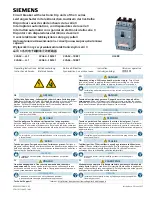
ABB Power Distribution
9
3
Structure and function
3.1
Structure of the breaker poles
(Figures 3/1, 3/2 und 3/5)
The 36 kV circuit-breakers of type VD4 are
intended for permanent installation.
The poles, which are constructed in column form,
are mounted on a torsionally rigid enclosure sub-
structure with rollers. The live parts of the breaker
poles are located in the insulating material pole
tubes 57.8 and protected from impacts and other
external influences.
With the breaker closed, the current path leads
from the upper terminal 57.1 and a chamber holder
fixed in the pole tube to the fixed contact 58.2 in the
vacuum interrupter 58, then via the moving contact
58.3 and roller contact to the lower terminal 57.2.
The switching motion is effected by means of the
insulated coupling rod with internal contact force
springs.
The basic structure of a vacuum interrupter is
explained in figure 3/5.
3.2
Structure of the breaker operating mechanism
(Figures 3/4, 7/2 und 7/3)
The operating mechanism located in the housing
substructure is of the stored-energy spring type
and acts on the three breaker poles. The necessary
operating energy is stored ready for activation by
charging the spring energy storage mechanism.
The stored-energy spring mechanism essentially
consists of drum 55.33 containing the spiral spring,
the charging system, the latching and operating
mechanism and the linkages which transmit the
force to the breaker poles. In addition, there are
supplementary components such as the charging
motor, releases, auxiliary switches and the controls
and instruments.
The operating mechanism is fundamentally suitable
for autoreclosing and, due to the short charging
times, also for multi-shot autoreclosing.
The operating mechanism is normally fitted with a
charging motor. There is also a facility for charging
the stored energy spring manually.
There is one rating plate 55.7 with the main data of
the switch equipment on front plate 50.7, and
another on breaker mechanism housing.
The
basic version
of the stored-energy spring
mechnism is fitted with the following auxiliary
equipment:
• Shunt release OFF Y2
• Five-pole auxiliary switch S4 for annunciation
purposes
• Auxiliary switch S7 for fault annunciation
• Mechanical ON push-button 54.2
• Mechanical OFF push-button 54.3
• Mechanical switch position indicator 55.4
• Charging condition indicator 55.8 for the spring
energy store
• Mechanical operating cycle counter 55.5.
The following additional equipment can be
installed:
• Blocking magnet Y1 with auxiliary switch S2
• Shunt release ON Y3
• Second shunt release OFF Y9
• Indirect overcurrent release Y7
• Undervoltage release Y4
• Five-pole auxiliary switches S3 and S5
• Charging motor M0
• Five-pole auxiliary switch S1 to switch the
charging motor
• Anti-pumping relay K0.
3.2.1
Releases, blocking magnet and auxiliary switches
(Figure 7/3)
The releases and the blocking magnet are
mounted at the bottom of the stored-energy spring
mechanism.
The allocation of the auxiliary switches can be seen
in the wiring diagram of figure 7/3.
The five-pole auxiliary switch S1 is operated by the
charging condition indicator 55.8. It controls the
charging motor M0, serves as an electrical interlock
for shunt release ON Y3 when the spring energy
storage mechanism is not sufficiently charged, and
also provides an electrical switching readiness
signal.
Operation of the five-pole auxiliary switches S3, S4
and S5 is dependent on the switching position of
the circuit-breaker.
Auxiliary switch S3 interrupts the circuit of the op-
tional additional shunt release OFF Y9 with the
circuit-breaker in the open position, and the circuits
of shunt release ON Y3 and the optional blocking
magnet Y1 with the circuit-breaker in the closed
position. There is one further NOC for other
purposes.










































